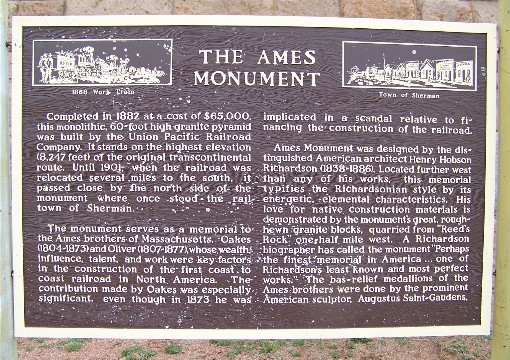
Ames Monument Historical Plaque
Posted by:  NevaP
NevaP
N 41° 07.869 W 105° 23.878
13T E 466596 N 4553392
This attractive plaque stands by the massive Ames monument.
Waymark Code: WM1N8Q
Location: Wyoming, United States
Date Posted: 06/07/2007
Views: 138
The Ames Monument is a huge granite pyamid, sixty feet high. It honors the contributions of Oakes and Oliver Ames in the costruction of the first transcontinental railroad. This marker near the monument is about the Ames brothers and the monument itself.

The Monument Plaque reads: "The Ames Monument. Left picture reads 1868 Work Train; right side picture is Town of Sherman. Completed in 1882 at a cost of $65,000, this monolithic, 60-foot high granite pyramid was built by the Union Pacific Railroad Company. It stands on the highest elevation (8,247 feet) of the original transcontinental route. Until 1901--when the railroad was relocated several miles to the south, it passed close by the north side of the monument where once stood the rail-town of Sherman.
The monument serves as a memorial to the Ames brothers of Massachusetts. Oakes (1804 - 1873) and Oliver (1807-1877), whose wealth, influence, talent, and work were key factors in the construction of the first coast to coast railroad in North America. The contribution made by Oakes was especially significant even though in 1873 he was implicated in a scandal relative to financing the construction of the railroad [Credit Mobilier scandal].
Ames Monument was designed by the distinguished American architect Henry Hobson Richardson (1838 - 1896). Located further west than any of his works, this memorial typifies the Richardsonian style by it energetic, elemental characteristics. His love for native construction materials is demonstrated by the monument's great, rough-hewn granite blocks, quarried from "Reed's Rock" one-half mile west. A Richardson biographer has called the monument "Perhaps the finest memorial in America...one of Richardson's least known and most perfect works." The bas-relief medallions of the Ames brothers were done by the prominent American sculptor, Augustus Saint-Gaudens."